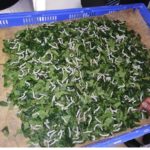JB Institute of Technology always take a keen interest in promoting updated and purposeful professional education to the students , for which the Institute always take immense efforts in providing best learning opportunities to its students to frame their promising career . In continuation of the same , an Industrial Visit to Regional Sericulture Research Station, Sahaspur, Dehradun , was arranged for B.Sc. Agriculture students on 16th March 2019 under the mentorship of Mr. Shubham Chaudhary – Head of Agriculture Department and Dr. Priyanka Baccheti . The objective of the visit was primarily to seek knowledge about the economic importance of Silkworm . Secondly , to aware the students about identification , life cycle and rearing method of silkworm species . Thirdly , to inform the students about major pest of silkworm and its management. Dr. Meenakshi – Senior Technical Officer from the Research Center in her presentation informed the students about the identification and life cycle of silk worm. According to her , To produce raw silk, from silk pests is called sericulture , silk moth or ‘silkworm rearing’. Silk was first introduced in China in the world. China is the first country in natural silk production, followed by India. Every species of silk is produced in India. The meaning of silk production is to follow silk-producing organisms to obtain silk in large quantities. It has now taken the form of an industry. It is generally viewed as a cottage industry based on agriculture. In terms of production process, Silk is of two types – Mulberry Silk and Non-Mulberry Silk.
-
1. Mulberry Silk – Silk-worm (worm) which creates silk by making mulberry leaves of plants is called mulberry silk. Mulberry plants are cultivated for receiving leaflets.
2. Non-Mulberry Silk – It contains coconut and coriander and eri (castor) silk.
Later , Dr. Pankaj Tiwari – Scientist ‘D’ , brilliantly explained the economic importance of Silkworm by giving his apt presentation . He informed the students that Silk is the only cash crop of the agricultural sector, which provides returns within 30 days. The varieties of silk are produced by Tribal people of Central and Northeastern India. The value of silk is very high . Silk provides value-added product of economic importance. In the world geographically, the highest yield of silk in Asia is about 95% of the world’s total product. Although 40 countries produce Silk, but more quantity is produced in China and India and after that in Japan, Brazil and Korea. China has been a pioneer in supplying Silk to the world. India, being the largest consumer of silk, is the only country to produce five varieties of silk-mulberry, tussar, oak tussera, ery and coral silk . According to him , India accounts for 18% of the world’s total silk production. Approximately 50% of the country’s total silk production is in Karnataka followed by Andhra Pradesh, Tamil Nadu and West Bengal respectively. The silk fabrics account for 3% of India’s total textile exports. Silk industry is very beneficial for the environment as well as for the fashion industry. India is currently the second major producer of crude silk after China in the world. The Industrial Visit was quite purposeful and informative.
- Regional Sericulture Research Station, Sahaspur, Dehradun
- Regional Sericulture Research Station, Sahaspur, Dehradun
- Regional Sericulture Research Station, Sahaspur, Dehradun
- Regional Sericulture Research Station, Sahaspur, Dehradun
- Regional Sericulture Research Station, Sahaspur, Dehradun
- Regional Sericulture Research Station, Sahaspur, Dehradun
- Regional Sericulture Research Station, Sahaspur, Dehradun
- Regional Sericulture Research Station, Sahaspur, Dehradun
- Regional Sericulture Research Station, Sahaspur, Dehradun
- Regional Sericulture Research Station, Sahaspur, Dehradun
- Regional Sericulture Research Station, Sahaspur, Dehradun
- Regional Sericulture Research Station, Sahaspur, Dehradun
- Regional Sericulture Research Station, Sahaspur, Dehradun
- Regional Sericulture Research Station, Sahaspur, Dehradun
- Regional Sericulture Research Station, Sahaspur, Dehradun
Thank you for visiting the Academic Portal of JBIT!
To Academic Portal Click Here.
Click here to go back to www.jbitdoon.com
















